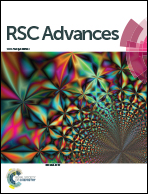Three-dimensional NiCo2O4/NiCo2S4 hybrid nanostructure on Ni-foam as a high-performance supercapacitor electrode†
Abstract
The spinel structured ternary mixed metal oxide NiCo2O4 and sulphide NiCo2S4 are considered as promising pseudocapacitive materials. In view of this, the present work involves the fabrication of NiCo2O4 nanosheets and a NiCo2O4/NiCo2S4 hybrid nanostructure on Ni-foam as a conductive substrate by a facile ammonia evaporation technique. The NiCo2O4/NiCo2S4 hybrid nanostructure exhibits remarkable supercapacitive performance compared to bare NiCo2O4 nanosheets due to its three dimensional open structure and synergistic effect of NiCo2O4 and NiCo2S4. The hybrid nanostructure exhibits a specific capacitance as high as 3671 F g−1 at a current density of 1.8 A g−1 and 2767 F g−1 at 9 A g−1 with a capacity retention value of 84% at 10 A g−1 after 2000 cycles. Furthermore, the electrode composed of the NiCo2O4/NiCo2S4 hybrid nanostructure displays a noticeably high energy density as well as power density (8820 W kg−1 at 41.65 W h kg−1) compared to the NiCo2O4 nanosheets (5374.28 W kg−1 at 20.90 W h kg−1) with great flexibility. It is anticipated that the combination of materials and the special structural design lead to fast electrochemical redox reactions, fast electron/ionic transportation and mechanical integrity, which promote the NiCo2O4/NiCo2S4 hybrid nanostructure as a superior electrode in high performing flexible supercapacitors.


 Please wait while we load your content...
Please wait while we load your content...